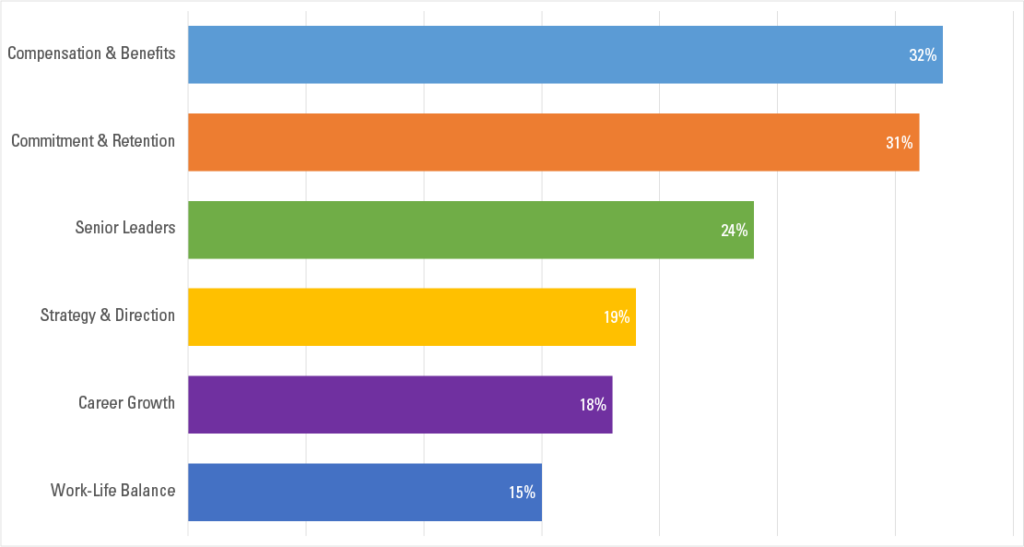
With many signs pointing toward a global financial slowdown in the near future, businesses everywhere are considering the need to preserve their two most precious resources: people and cash flow.
Unlike “the great resignation” and “quiet quitting” — HR phenomena with catchier names and relatively lower impact — economic downturns can affect even the most insulated businesses. Leaders and people managers should be solving for these three distinct phases:
- Pre-recession: When you must build a culture that can withstand what’s coming.
- During the recession: When you must lead with clarity and empathy.
- Return to normalcy: When you must recover with speed and stability.
The solution is equal parts keeping your best people and keeping them happy, and there’s plenty you can do during each phase of the journey.
Pre-recession: Building a Positive Culture in Preparation of Hard Times

Lean times can be less rough if you identify and retain your top talent, but there’s long-term success to be found in creating a culture that attracts and retains high performers even after the recession passes.
A business capable of withstanding a recession has five hallmarks:
- Constant focus on employee well-being, including monitoring for signs of burnout and tailoring benefits in a way that’s sensitive to employee morale
- Empowered managers who are capable of balancing flexibility and fairness, have the freedom to exercise their judgment and receive the coaching and resources necessary to retain a high level of effectiveness
- High engagement driven by buy-in to the company culture, which is nurtured in part by strong onboarding, mentorship, and availability of resources
- Equitable treatment of all employees, with differences in flexibility deployed in a way that minimizes resentment
- Unbiased performance monitoring systems that judge employees based on results and outcomes, rather than aspects like visibility to senior leadership or hours worked
New research suggests a strong correlation between high inclusion sentiment — especially among people of diverse racial, ethnic, and socioeconomic backgrounds in the company — and companies that turn out successful at the end of challenging periods (keep in mind that this is strictly correlation, not causation; there are many more moving pieces and challenges to solve).
Since the pandemic, many businesses have realized how closely linked communication, culture, and success are. They’ve changed the tone of their conversations with employees, discovered what’s truly important to them, and improved relationships by delivering on those needs.
Ignoring the value of culture ahead of a recession is to discard that progress and risk disrupting the foundation of your company — a bill that will eventually come due during the recovery phase when businesses start hiring again. Statements like, “Come back to the office or find another job,” will likely not age well during that critical period.
During the Recession: Lead with Transparency and Empathy
Leaders really start to feel the pressure once cash flow starts to get affected. At that stage, it can be tempting to ignore the game plan and hit the layoff button right away. While it’s not always avoidable, it should be your last resort and done in a way that preserves the dignity of both sides.
Preserve two-way communication with employees
If your company must cut costs, listening to employees is the first step to doing so thoughtfully. Feedback is the best way to stay in touch with what your people truly value, whether it’s how they work or which benefits they’re willing to sacrifice.
Employees need you to address issues proactively and keep them abreast of changes in the economic environment and their impact on the company. They need to know what’s going on around them and whether it might affect their individual situations.
When our customers survey their employees during times of change, the top theme that emerges is communication. Within this, Culturebie sees topics like transparency, frequent updates (with clarity and purpose), individual impact (job safety), company strategy (acquisitions, mergers, major strategic changes), and leader visibility (active presence of senior leadership).
Some of them keep hearing from their people: “Are you being honest with us? Where is the business at? You’ve been too quiet.”
Working through a recession can be exhausting enough without the added worry of wondering what your company is going through. Employee feedback provides that reassurance while helping businesses find out how best to enable work-life harmony, make people feel recognized and valued, and reward top performers during lean periods.
That doesn’t mean communication is easy, especially when it’s about cost-cutting.
If you run a company or an HR team, you know the perils of announcing these measures with advance notice; the chaos and uncertainty it creates. And yet, employees may find a lack of notice to be worrying, or even see it as a reason to break trust. The middle ground here can be narrow, but it’s important that you find it.
If you must conduct layoffs, do so compassionately
I once worked for a company that conveyed it was so resource-rich, layoffs were never a thing. Yet just one year after I was told so, they let 5,000 global employees go. Leadership ignored the alternatives — hiring freezes, reskilling, moving people into new roles — and went straight to layoffs.
One person I had to let go was still relatively new. He had relocated alone and was living apart from his wife, who’d finally bought flight tickets to join him when I delivered the news. His tears and fears were just part of the price the company was willing to pay to impress its institutional investors.
I’m seeing similarly disappointing behavior in recent weeks, where cost-cutting measures are communicated in ways that harm employee welfare or cause worry. Even for those spared from initial layoffs, ambiguity can make them wonder if they’re next. You don’t have to look too far for examples:
- A major e-commerce tech company laid off 10 percent of its workforce and made a $100 million investment in another company during the same month.
- One of the largest public companies in the world got frustrated with employees who expressed frustration with budget reductions despite record-breaking profits.
- The founder of a home mortgage company fired 900 employees via Zoom while calling them “lazy.” While layoffs via Zoom are part of today’s world, you don’t want insensitive people delivering the message without tact or decency.
There are also examples of great leadership to follow.
I recently spoke to a peer who was the CEO of a fast-growth medical startup. His investors had practically taken control of the company and wanted to lay off employees rather coldly. He couldn’t subscribe to causing that impact under the pretense of “business as usual.”
Despite his best efforts in fighting for his employees, his investors would not compromise. So when they went over his head to lay off those employees anyway, he quit too. In doing so, he gave up a comfortable job at a company he founded because it no longer aligned with his values. It’s so rare to see a leader put their money where their mouth is.
While this is an extreme example, the lesson is the same. Even when business optimization needs to happen, it can be done thoughtfully — with heart, spread out to buy time, or in a manner that spares jobs. The human approach is better than shows of bravado, both for one’s soul and the long-term health and culture of a business.
Return to Normalcy: Emerge a Stronger, Wiser Organization
Let’s fast-forward the timeline. Things are now looking better, you’re hiring again, and you want those still with the company to focus on recovery. How do you get them to buy into your future?
If you have open positions, so do other companies. Retention will be easier if you’ve done the right things so far — took stock of company culture; nurtured top employees; made tough but fair decisions about investments, resources, and structure; and communicated them openly and on time.
Even with all these boxes checked, your engagement strategies must vary based on the employee group. For example, in our 2022 study of employee feedback from approximately 4,000 survey participants, we saw variance in what motivates employees to stay at a company, based on how they are compensated.
Hourly Wage Employees

Salary Wage Employees

Then there are those employees who are among the very best at what they do; the top 10 percent of their profession who, even during a recession, can typically choose where they want to work. These folks have a fair bit more freedom and will require greater effort on your part to retain, so continue giving them reasons to choose yours.
High Wage Employees

In all cases, companies hold the balance of power, and larger ones with highly coveted employer brands typically have more leeway. Smaller businesses don’t have as much leeway when it comes to reputation and can afford fewer mistakes.
One of my newer connections is a marketing director at a bootstrapped tech company who had his annual performance review in August. He was one of a handful of top performers to get the biggest rewards.
More importantly, even those who fell short of expectations got raises that kept pace with the actual cost of living. All numbers were still considerably lower than what they would have been awarded under normal circumstances.
Reviews were accompanied by a message from leadership that hiring would continue at a reduced pace, that there was money in the bank to sustain the company for an extended period even if revenue drops to zero, and that no one would lose their jobs due to economic reasons this year or next.
This perfectly illustrates what the best-run companies know: It takes so much more than a fair or generous paycheck to earn employee loyalty.
Your brightest people aren’t just your best chance at weathering this recession; they’re your only chance. Treat them like the partners they are, build them a culture they’ll stick by through thick and thin, and you’ll emerge on the other side of this with a resilient group capable of doing great things.
Be sure to check out Jasmit’s other contributions about company culture!
In Tough Times, Company Culture Makes the Difference
Rethinking Company Culture